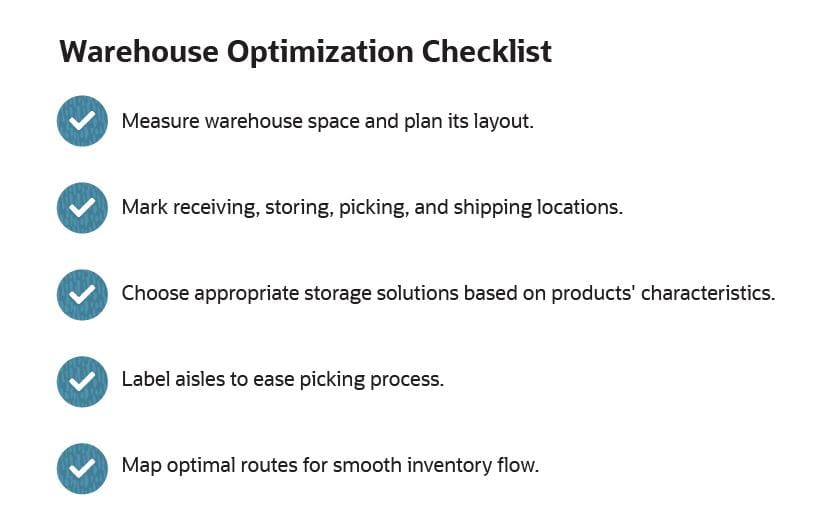A disorganized, inefficient warehouse can create trouble for businesses, leading companies to miscount inventory, order stock it doesn’t need and send out the wrong shipments to customers — all of which can lead to financial losses. So it’s little wonder why companies are increasingly seeking ways to optimize their warehouse operations, often by identifying inefficiencies and automating much of the tedious, manual work that can result in human error. When a company improves its processes, keeping stock levels balanced based on customer demand and moving inventory efficiently through the warehouse, it can fulfill orders accurately and on time while keeping supply chain costs in check. Even making simple changes to warehouse operations, such as revising delivery routes, can enhance the speed, reliability and cost of warehouse processes.
What Is Warehouse Optimization?
Warehouse optimization is the continuous process of making changes, such as implementing modern technology and automating tasks, to help a warehouse run at peak efficiency. In fact, the market for warehouse automation is projected to reach $54.6 billion by 2030, marking a 175% increase over 2022. Improvements in the way a business manages its people, spaces, inventory and resources can ensure the company stocks enough products to meet customer demand and fulfills orders in a timely manner. Improvements can also boost productivity and drive business growth.
Businesses are increasingly focused on creating a warehouse environment that empowers their teams to work productively and make the most of every minute on the job by employing the fastest, most cost-effective ways to receive, pick, package and ship products to customers.
Key Takeaways
- Warehouse optimization makes the processes within a warehouse run more efficiently by ensuring businesses make the best possible use of their warehouse spaces, technologies and staff time.
- An optimized warehouse helps businesses maximize their inventory capacity and accelerate the flow of products, which in turn can drive sales and increase customer satisfaction.
- Warehouse management software helps teams manage an increasing array of inventory efficiently, informed by data-driven insights.
Warehouse Optimization Explained
A warehouse’s day-to-day operations include tasks such as receiving, storing, picking, packing and shipping products. Warehouse optimization requires businesses to zoom in on all of these processes and address inefficiencies so the warehouse can operate in a quicker, more unified way.
After all, optimization isn’t just about simplifying individual warehouse processes. It’s also about integrating these processes to ensure a seamless flow of inventory among warehouse teams. For example, miscounting inventory upon receipt can slow fulfillment with partners and customers downstream. Without a coordinated, well-managed warehouse operation, businesses risk falling into a repetitive trap of delays, leading to dissatisfied customers, increased product returns and shrinking profits.
Importance of Warehouse Optimization
A slow-functioning, poorly organized warehouse can make it difficult for businesses to flourish. Warehouse inefficiencies can add up over time, which can manifest in delayed orders and inventory stockouts. Those issues have the potential to compromise a company’s customer relationships, eat into profit margins and create bottlenecks that stand in the way of growth.
An optimized warehouse that runs smoothly and efficiently can serve as a solid foundation for any business that receives, stores and ships inventory, including retailers, ecommerce companies and manufacturers. Growth-oriented companies that need to scale their warehouse operations quickly to meet rising customer demand for their products should consider optimizing their warehouse processes to manage higher volumes of products.
Why Optimize Warehouse Operations
Warehouse managers must strike a balance between maintaining sufficient inventory levels and meeting customer demand. While it may be tempting to bolster safety stock, this approach can cause storage, labor and other carrying costs to spiral out of control. What’s more, overstocks takes up valuable warehouse space that could be used for more in-demand items.
On the other hand, companies that minimize their inventory risk falling short of customer expectations and losing business. Consider a technology retailer that officially announces it will sell 100,000 units of the year’s most in-demand smartphone on Black Friday. If the business receives 100,000 units but its warehouse can only process and ship 10,000 units to customers per week, it could struggle to deliver on its promises in a timely manner and see its reputation suffer.
An optimized warehouse also helps companies avoid financial losses. Every time a team member miscounts inventory or a damaged shipment is sent to a customer and must be returned, the business must absorb the cost of fixing that mistake. A lack of visibility into inventory locations can also slow down order picking operations, which in turn backs up dependent processes, such as loading, dock scheduling and fulfillment.
Optimizing Warehouse Space
A cluttered warehouse environment presents a series of obstacles that often lead to delays, bottlenecks and higher fulfillment costs. The goal for businesses is to use their space as efficiently as possible to maximize warehouse capacity while reducing clutter to manage inventory effectively and safely.
Warehouse optimization begins with a well-organized space. From the moment new inventory arrives, having a clutter-free area to receive the order sets the pace for the smooth flow of products through every warehouse process until they are eventually shipped to customers. For instance, creating clear picking routes speeds up the process of retrieving inventory, even as volumes rise. Free and clear spaces also make the warehouse environment safer for employees, especially those climbing ladders or using forklifts to transfer inventory.
Warehouse capacity will depend on the types of products being stored, so space requirements may change over time. For example, a sporting goods retailer might organize its warehouses to store items like skis and snowboards in the front of the warehouse in the winter and change the layout in the summer so that items like sunglasses and hiking shoes are more easily accessible.
The Benefits of Warehouse Optimization
Warehouse optimization can provide businesses with many advantages, from better inventory forecasting to improved customer satisfaction and retention. Here are some of the top benefits of optimizing warehouse operations.
- Better forecasting: With greater transparency and more accurate supply and demand data, businesses can better predict the amount of inventory they will need at any given time and maximize their storage capacity. Improved forecasting prevents companies from ordering more products than they can manage or, on the flip side, not ordering enough to meet customer demand.
Ready to Eliminate Obsolete Inventory?

- Improved customer retention: The ability to receive products on time is a key consideration for customers when deciding whether to place repeat orders with a business. If a customer’s first order is wrong or arrives late due to a warehouse issue, the buyer may lose trust in the business and buy from a competitor next time.
- Reduced time and lower labor costs: In an optimized warehouse, all employees work to their full potential without burning out. It also prevents businesses from incurring overtime costs, which can snowball quickly in a warehouse that is regularly struggling to keep up with demand. Plus, when automation takes care of tedious, manual tasks, orders get processed quickly, and employees can focus on more high-level work.
- Driving scalable growth: When a warehouse’s people, processes and spaces are fully optimized, the business can more easily scale its operations to meet customer demand and accommodate new product lines to generate additional revenue streams.
8 Tips for Optimizing Warehouse Operations
The key to optimizing warehouse operations is to simplify and streamline processes wherever possible. From arranging optimal picking paths and strategically placing stock to using robotics and warehouse management software to automate processes and reduce human error, here are eight ways businesses can optimize their warehouse environments.
- Minimize the number of touches. While employees are essential to a successful warehouse operation, machines can handle certain tedious and repetitive tasks so that staff can focus on higher-value work. To ensure the rapid flow of inventory through the warehouse, businesses can automate simple processes, letting technology, such as software and robots, take care of picking, packing and shipping products.
- Balance capacity with efficiency. An ideal warehouse is one that stores the highest volume of inventory possible while moving that inventory through warehouse processes as efficiently as possible. Striking this balance comes down to a combination of creating the right storage layout, making the best use of warehouse space and continuously refining warehouse processes to make inventory flow seamlessly from one stage to the next.
- Invest in robotics. Businesses increasingly use robots, drones and automated storage and retrieval systems (AS/RS) to move inventory. Large ecommerce companies have been trailblazers in this domain, using inventory automation and relying on machines to take on labor-intensive tasks. In addition to removing physical labor off employees’ plates, robots can also make warehouse processes more consistent, reliable and safe.
- Organize based on product velocity. The rate that a product sells, also known as its product velocity, often dictates how fast it needs to move through a company’s warehouse. Certain products, like the holiday season’s hottest gifts, heavily discounted items or perishable goods, move more quickly than others. By planning the layout of their warehouses so they can easily retrieve and ship these items, businesses can position themselves to meet these demand spikes and avoid missing new sales opportunities.
- Stock materials based on logical sequencing. A smooth-running warehouse is, to say the least, well-organized. The best way to avoid losing or misplacing inventory is to store it in places where employees will intuitively find it. For instance, a warehouse that stores groceries is unlikely to place perishable items on high shelves or in dark corners that are difficult to access. By stocking products in a logical manner, businesses will ensure items are easy to find, pick, pack and ship, saving time and reducing employees’ workload.
- Automate shipping routing. Fulfillment is one of the most important warehouse activities to optimize. Rather than relying on employees to route shipments to the correct collection areas, companies can use order routing automation tools to streamline the process and ensure the right products go to the right place at the right time.
- Align operations with business KPIs. With so much pressure placed on modern warehouses to run at high speed, it’s easy to let short-term demands derail long-term business objectives. For example, a car manufacturer building an inventory of a new electric vehicle in time for its public launch might be distracted by a spike in demand for one of its other cars. In these moments, it’s important to take a step back, consider the company’s broader objectives and align warehouse metrics and key performance indicators (KPIs) with strategic business goals, rather than constantly focusing on short-term wins.
- Use warehouse management software. A warehouse management system (WMS) takes the complexity out of managing warehouse processes by giving businesses visibility across their operations and allowing them to automate time-consuming tasks. For instance, many businesses use a WMS to gain real-time insight into the location and volume of their inventory to avoid ordering too many products or not enough. A WMS not only improves the efficiency of warehouse operations, but it also helps businesses avoid stock control issues and unnecessary costs and reduces the risk of human error.
Warehouse Optimization Checklist
The measures a business takes to optimize its warehouse will depend on its specific objectives. One point to keep in mind: Every tactic a business implements in one part of its warehouse will likely have knock-on effects that impact other processes. With so many moving pieces to consider, creating an ongoing optimization checklist can help guide the implementation process. Here are five crucial tasks businesses may want to follow for a successful optimization process.
- Understand your warehouse space inside and out. To maximize capacity and ensure an efficient flow of items through the warehouse, a company first needs to understand the space it is working with. Square footage is just part of the equation. Capacity will also be dictated by the specific layout a business adopts for different types of inventory and how quickly teams need to move through the warehouse when picking, moving and packing items for shipment.
- Define clear locations for products. When warehouse employees have a solid handle on the exact locations to receive, store, pick and ship every piece of inventory, they can complete all of these processes efficiently. This is particularly important when handling high-velocity items, since confusion can lead to costly delays, missed sales and dissatisfied customers.
- Choose storage solutions specific to your inventory. The way a product is stored depends on a number of variables, including its size, weight and sensitivity. For instance, the considerations around storing fresh produce are completely different from the requirements of storing office furniture. Businesses must take these factors into account when choosing the storage solutions that best meet their needs, whether they require heavy-duty shelving for industrial goods or temperature-controlled rooms for perishable foods.
- Label picking aisles for easier navigation. Employees need clear cues to find items amid the enormous volume of inventory in a large warehouse. The simple act of labeling aisles takes the guesswork out of inventory picking, making the process faster, more efficient and less prone to error.
- Indicate the optimal route for inventory flows. Inventory can flow through a warehouse in countless ways, but only certain strategically mapped routes will tick every box for speed and efficiency while respecting product-specific handling considerations. Indicating the best route for inventory as it makes its way through the warehouse is yet another way to ensure consistent warehouse operations and satisfied customers.

Implementing a Warehouse Optimization Plan
When implementing a warehouse optimization plan, businesses would be wise to set benchmarks for inventory receiving and handling times, stock management and the flow of products through their warehouses to gauge their performance over time. They may also want to consider how their in-warehouse processes feed into fulfillment and last-mile delivery to ensure customer satisfaction.
Indeed, businesses always need to consider customer expectations when developing their warehouse optimization plans. From scheduling quick order deadlines to efficiently handling shipments, every piece of the puzzle must fit together seamlessly to ensure a warehouse operation is truly optimized for the customer’s benefit.
The most successful businesses also eliminate silos among warehouse decision-makers to ensure alignment between business strategies and warehouse priorities. When business operations and supply chain management teams plan for changes together, they can develop optimization strategies that meet both of their goals, which can not only improve their working relationship but also maximize profits for the business.
In addition, remember that warehouse optimization plans must evolve in line with changing business priorities, customer demand and market fluctuations — as well as the advent of innovative technologies that allow for greater efficiencies in warehouse processes. By tracking and analyzing data on their warehouse operations at a granular level, businesses can foster a culture of continuous improvement across every warehouse process.
Warehouse Optimization Trends
Warehouse optimization plans can change over time, particularly as boardrooms shift their priorities, consumer trends evolve and technology advances. To ensure they adopt the latest warehouse optimization methods and technologies, it’s a good idea for businesses to re-evaluate their optimization plans every few months and adjust them as needed.
It’s also helpful to keep an eye on warehouse optimization trends for inspiration. For instance, a business struggling with its inventory management might explore the use of Internet of Things (IoT) sensors to better track and manage its warehouse stock. A retail brand that needs more warehouse space to stock a seasonal product line might investigate flex design, which allows companies to temporarily expand their warehouse capacity to store and move a periodic spike in products.
Some warehouse management trends are more internally focused. For instance, human-centric design involves building warehouse environments that improve employees’ quality of life, whether that involves installing air purifiers throughout the warehouse to freshen the environment or building recreation areas where employees can eat, work out and socialize between shifts. Not only do these measures motivate current employees, but they could help businesses attract new talent.
Manage Warehouse Operations Better With NetSuite
Warehouse management systems are invaluable to businesses that are eager to optimize their warehouse operations. From radio frequency barcode scanning and defined strategies for stock putaway and picking to task management and cycle count plans, NetSuite Warehouse Management optimizes every part of a warehouse’s day-to-day operations according to the most up-to-date best-practice principles.
For example, mobile receiving and predefined putaway strategies ensure every item in a warehouse is received accurately and that all relevant data is added to the inventory record in real time. To optimize warehouse spaces, NetSuite WMS helps businesses store every piece of inventory in the most logical location and adopt the most efficient picking strategy. For instance, the solution will identify high-velocity items that should be stored as close to primary picking lanes as possible during a particular shopping season, so the products can be accessed more quickly.
Warehouse optimization delivers value for businesses both inside and outside of the warehouse, from generating speed and efficiency gains in their inventory operations to improving sales and customer satisfaction on the demand-side of the equation. With a well-thought-out optimization plan, businesses can make the best use of their warehouse spaces, resources, people and technologies to continuously accelerate their operations and drive sales and growth.
Award Winning
Cloud Inventory
Warehouse Optimization FAQs
How can businesses optimize inventory space for many SKUs?
Businesses that store many different types of products in their warehouses may consider focusing on two ways to optimize their spaces. First, high-velocity products that are likely to move in and out of the warehouse quickly can be placed close to picking lanes and loading areas. Second, companies can use robots and automation software to track, pick and package products at scale while minimizing the number of human touches needed.
Does warehouse optimization affect sales?
An optimized warehouse allows businesses to operate at peak capacity and efficiently process sales orders. What’s more, warehouse optimization ensures the timely delivery of customer orders, which builds loyalty and promotes repeat sales.
What are the main objectives of a warehouse operation?
The main objectives of a warehouse operation are to receive, store and deliver a business’s products to customers in the most efficient way possible. By optimizing the flow of inventory through receiving, storage, picking, packing and fulfillment, a smooth-running warehouse can become a driver of sales and profitable growth.
How do you optimize warehouse operations?
Businesses can optimize their warehouse operations in a number of ways. The most common include strategic picking strategies based on logical sequencing, the use of automation software and robots for increased productivity, and the optimization of warehouse spaces to maximize inventory capacity.
What are the five essential warehouse management processes?
Warehouse management refers to the processes and principles a company applies to run its warehouse on a daily basis. Five of the most essential warehouse management processes involve receiving, storing, picking, packing and shipping goods to customers.
Why is warehouse optimization important?
Warehouse optimization helps businesses meet customer demand for their products while working in the most efficient and cost-effective ways possible. Errors or bottlenecks in a warehouse operation can also have a negative impact on a company’s relationship with partners and customers, especially if they cause delivery delays.
How do I optimize my warehouse capacity?
To optimize a company’s warehouse capacity, the business should focus on optimizing its warehouse space while improving the efficiency of its warehouse processes. This requires balancing two needs: making the most of square footage and ensuring warehouse teams can easily navigate inventory to pick and ship products to customers on time.









